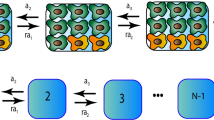Abstract
Multistage mathematical models of carcinogenesis (when applied to tumor incidence data) have historically assumed that the growth kinetics of cells in the malignant state are disregarded and the formation of a single malignant cell is equated with the emergence of a detectable tumor. The justification of this simplification is, from a mathematical point of view, to make the estimation of tumor incidence rates tractable. However, analytical forms are not mandatory in the estimation of tumor incidence rates. Portier et al. (1996b, Math. Biosci. 135, 129–146) have demonstrated the utility of the Kolmogorov backward equations in numerically calculating tumor incidence. By extending their results, the cumulative distribution function of the time to a small observable tumor may be numerically obtained.
Similar content being viewed by others
References
Cox, D. R. and H. D. Miller (1965). The Theory of Stochastic Processes, London: Chapman and Hall, p. 216.
Dewanji, A., S. Moolgavkar and E. Luebeck (1991). Two-mutation model for carcinogenesis: joint analysis of premalignant and malignant lesions. Math. Biosci. 104, 97–109.
Dewanji, A., D. Venzon and S. Moolgavkar (1989). A stochastic two-stage model for cancer risk assessment. II. The number and size of premalignant clones. Risk Anal. 9, 179–187.
Gart, J., D. Krewski, P. Lee, R. Tarone and J. Wahrendorf (1986). Statistical Methods in Cancer Research III: The Design and Analysis of Long-term Animal Studies (IARC Scientific Publication No. 79), New York: Oxford University Press, pp. 122–127.
Harris, T. (1963). The Theory of Branching Processes, Berlin: Springer-Verlag, pp. 99–103.
Heidenreich, W. F. (1996). On the parameters of the clonal expansion model. Radiat. Environ. Biophys. 35, 127–129.
Kopp-Schneider, A. and C. Portier (1994). A stem cell model for carcinogenesis. Math. Biosci. 120, 211–232.
Kopp-Schneider, A. and C. Portier (1995). Carcinoma formation in NMRI mouse skin-painting studies is a process suggesting greater than 2 stages. Carcinogenesis 16, 53–59.
Kopp-Schneider, A., C. Portier and C. Sherman (1994). The exact formula for tumor incidence in the two-stage model. Risk Anal. 14, 1079–1080.
Luebeck, E. G. and S. H. Moolgavkar (1994). Simulating the process of malignant transformation. Math. Biosci. 123, 127–146.
Lyles, C. (1996). The modeling of cell proliferation: incorporating the cell cycle, Unpublished doctoral dissertation, Department of Biostatistics, University of North Carolina-Chapel Hill.
Maronpot, R. R., J. F. Foley, K. Takahashi, T. Goldsworthy, G. Clark, A. Tritscher, C. Portier and G. Lucier (1993). Dose response for TCDD promotion of hepatocarcinogenesis in rats initiated with DEN: histological, biochemical, and cell proliferation end-points. Environ. Health Perspect. 101, 634–642.
Moolgavkar, S. and E. G. Luebeck (1992). Interpretation of labeling indices in the presence of cell death. Carcinogenesis 13, 1007–1010.
Moolgavkar, S., E. Luebeck, A. Buchmann and K. Bock (1996). Quantitative analysis of enzyme-altered liver foci in rats initiated with diethylnitrosamine and promoted with 2,3,7,8-tetrachlorodibenzo-p-dioxin or 1,2,3,4,6,7,8-heptachlorodibenzo-p-dioxin. Toxicol. Appl. Pharmacol. 138, 31–42.
Moolgavkar, S. and D. Venzon (1979). Two-event models for carcinogenesis: incidence curves for childhood and adult tumors. Math. Biosci. 47, 55–77.
Portier, C. and A. J. Bailer (1989). Two-stage models of tumor incidence for historical control animals in the National Toxicology Program’s Carcinogenicity Experiments. J. Toxicol. Environ. Health 27, 21–45.
Portier, C., J. Hedges and D. Hoel (1986). Age-specific models of mortality and tumor onset for historical control animals in the NTP bioassay. Cancer Res. 4, 4372–4378.
Portier, C. J., M. C. Kohn, A. Kopp-Schneider, C. D. Sherman, R. Maronpot and G. W. Lucier (1996a). Modeling the number and size of hepatic focal lesions following exposure to 2,3,7,8-TCDD. Toxicol. Appl. Pharmacol. 138, 20–30.
Portier, C., A. Kopp-Schneider and C. Sherman (1996b). Calculating tumor incidence rates in stochastic models of carcinogenesis. Math. Biosci. 135, 129–146.
Sherman, C. and C. Portier (1995). Quantitative analysis of multiple phenotype enzyme altered foci in rat hepatocarcinogenesis experiments—the multipath-multistage model. Carcinogenesis 16, 2499–2506.
Sherman, C. and C. Portier (1997). The two-stage model of carcinogenesis: overcoming the non-identifiability dilemma. Risk Anal. 17, 367–374.
Sherman, C., C. Portier and A. Kopp-Schneider (1994). Multistage models of carcinogenesis: an approximation method for the size and number distribution of late-stage clones. Risk Anal. 14, 1039–1048.
Author information
Authors and Affiliations
Corresponding author
Rights and permissions
About this article
Cite this article
Sherman, C.D., Portier, C.J. Calculation of the cumulative distribution function of the time to a small observable tumor. Bull. Math. Biol. 62, 229–240 (2000). https://doi.org/10.1006/bulm.1999.0148
Received:
Accepted:
Issue Date:
DOI: https://doi.org/10.1006/bulm.1999.0148




